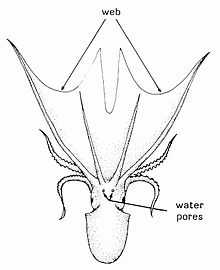Camera (cephalopod)
From Wikipedia, the free encyclopedia

Cutaway of a nautilus shell showing the chambers
Camerae (singular camera) are the spaces or chambers enclosed between two adjacent septa in the phragmocone of a nautiloid or ammonoid cephalopod. These can be seen in cross-sections of a nautilus shell and in the polished cross-sections of ammonites. In life these chambers are filled with gas, mediated by the siphuncle, and used to control buoyancy.
Some Palaeozoic nautiloid genera, especially those with long, straight shells, are distinguished by cameral deposits. These were accumulations of calcium carbonate secreted in the empty chambers of the shell, used for ballast and control of buoyancy. The nature and form of these deposits are very useful in nautiloid classification.
References
- Flower, R. H. (1955). "Cameral deposits in orthoconic nautiloids". Geological Magazine 92 (2): 89–103. doi:10.1017/S0016756800063408.
| |||||||||||||||||||||||||||||||||||||||||||||||
This article is issued from Wikipedia. The text is available under the Creative Commons Attribution/Share Alike; additional terms may apply for the media files.


